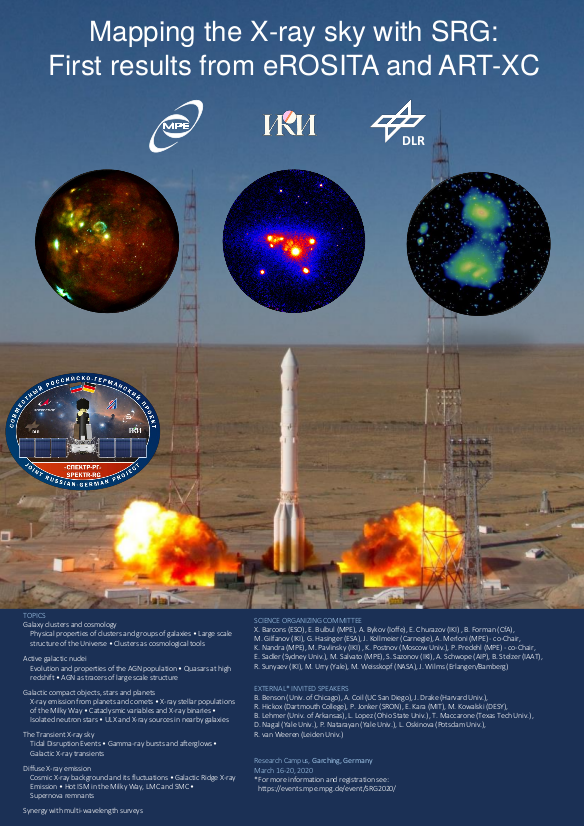


Please accept our sincere apologies for any disruption caused.
Further details about the rescheduling of the conference will follow in due course.
Scientific Rationale:
In little more than half a century, X-ray astronomy has established itself as a fundamental domain of observational astrophysics. X-rays probe the hot and energetic components of the Universe, encompassing, among others, the million degree coronae of stars, the remnants of supernovae, the ultra-dense matter in neutron stars, the immediate surroundings of black holes, the plasma filling galaxy clusters – the most massive objects in the Universe.
Successfully launched in July 2019, after more than a decade of development, the Russian-German Spectrum-RG (SRG) mission will contribute to the X-ray exploration of the Universe by performing eight all-sky surveys, each lasting half a year, with its two scientific instruments: eROSITA, the German-built telescope array operating between ~0.3-8 keV, and ART-XC, the Russian-built hard-X-ray focusing telescope array, operating between ~3-30 keV.
As in any other astrophysics domain, the SRG all-sky surveys will unlock large swathes of discovery space, provide large statistical samples to trace the cosmic evolution of various classes of objects, and explore sufficiently large volumes to serve as cosmological tools for the study the Universe as a whole. In particular, the high sensitivity, large field of view, and high survey efficiency of eROSITA is bound to revolutionize X-ray astronomy: within just the first year of operation it will discover about as many new celestial X-ray objects as have been discovered from 1962 until today.
The goal of the next international SRG conference (the third in a series, and the first after the SRG launch) is to discuss the state of the art in the different scientific areas addressed by the mission, present to the community the first results from eROSITA and ART-XC, and explore the synergies with surveys and observations at other wavelengths.
We plan to cover the following topics:
- Galaxy clusters and cosmology
- Physical properties of clusters and groups of galaxies
- Large scale structure of the Universe
- Clusters as cosmological tools
- Active galactic nuclei
- Evolution and properties of the AGN population
- Quasars at high redshift
- AGN as tracers of large scale structure
- Galactic compact objects, stars and planets
- X-ray emission from planets and comets
- X-ray stellar populations of the Milky Way
- Cataclysmic variables and X-ray binaries
- Isolated neutron stars
- ULX and X-ray sources in nearby galaxies
- The Transient X-ray sky
- Tidal Disruption Events
- Gamma-ray bursts and afterglows
- Galactic X-ray transients
- Diffuse X-ray emission
- Cosmic X-ray background and its fluctuations
- Galactic Ridge X-ray Emission
- Hot ISM in the Milky Way, LMC and SMC
- Supernova remnants
- Synergy with multi-wavelength surveys

